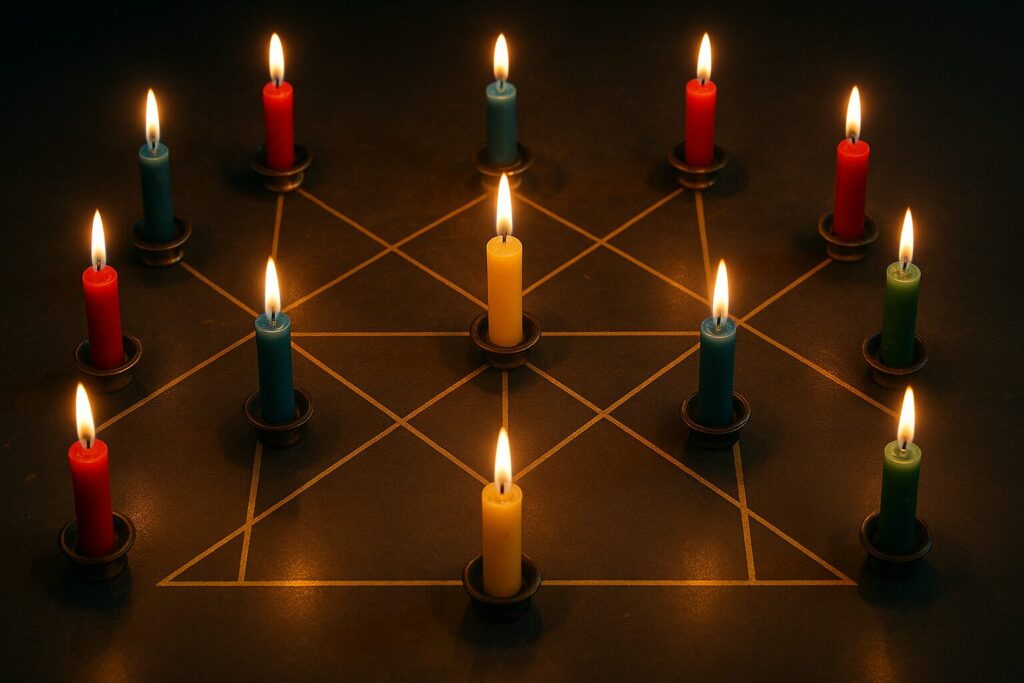Working with Candles

Working with candles is one of the most direct ways to practice magic. The method is simple—set an intention, kindle the flame, and attend to what follows—yet mastery comes from craft: how you choose, dress, place, time, and read the candle. What follows is a practical guide for the witch’s everyday work, with techniques you can adapt to your path.
Use what you have; refine as you learn. Keep a journal of burns, observations, and results—your record becomes a grimoire of lived experience.
1) Single-Candle Workings
A single candle carries a single aim. Carve the goal, name, or sigil into the wax. Dress upward (to draw) or downward (to release) with an oil that matches the intent, then roll lightly in corresponding herbs. Keep the altar uncluttered—let the flame be the focal point your mind returns to.
Common focuses: healing, protection, clarity, opening roads, blessing a threshold, or devotion to a deity or ancestor. Color is helpful but not mandatory; white can stand in for any hue if purpose is clear.
2) Linked / Paired Candle Spells
Two candles allow you to model a relationship between energies—people, goals, conditions. Connect them with a fine cord, a trail of wax, or a line of herbs.
- Bringing together: Place candles a hand’s width apart, light both, then nudge closer as the burn progresses. Speak to shared good, not control.
- Severing / releasing: Begin close, then move them apart as they burn, snuffing each in turn to symbolize closure.
- Self ↔ Goal alignment: One candle is you, one is the outcome. Place a small token of the goal between them. As the flames steady, move your candle slightly toward the goal.
3) Multi-Candle Layouts & Grids
Layouts let you shape the “geometry” of a working.
- Triangle: Will, form, transformation. Place your goal at the center; light clockwise.
- Square / Cross of Elements: North/Earth, East/Air, South/Fire, West/Water. Use colors or herbs per point; place the main candle in the middle as Spirit.
- Circle or Spiral: For cycles, blessings, and continuous protection. Spiral inward to manifest; outward to release.
Notice how flames lean: convergence suggests harmony; divergence can signal friction to resolve.
4) Reading Flame, Smoke & Wax
Flame: Tall/steady → strong, clear path. Low → resistance or under-charged working. Flicker/popping → interference, spirit activity, or mixed emotion—pause and re-center.
Smoke: Thin/upright → acceptance; swirling → confusion or cross-winds; thick/dark → heavy energy lifting (cleanse and repeat another day).
Wax: Even pool → harmonious progress. Tunneling → poor wick or misaligned focus. Drips/shapes → symbolic (record what you see first, then interpret). Abrupt self-extinguish → working complete or protection kicking in; ground and reassess.
5) Elemental Integration
Though a candle is ruled by Fire, it unites all four elements: wax (Earth), melting (Water), smoke (Air), flame (Fire), with Spirit holding them in balance. Emphasize an element to suit the work.
- Earth: Salt ring, stones, or herbal base for stability and manifestation.
- Water: Bowl or shell nearby for healing, cleansing, and emotional flow.
- Air: Feather or gentle incense for clarity, thought, and messages.
- Fire: Additional taper or brazier to raise power and courage.
If a working feels “too hot,” bring in Water or Earth. If dull, invite Air or a second candle to enliven Fire.
6) Carving, Dressing & Correspondences
Personalization focuses the current. Carve names, runes, or sigils with a pin or stylus. Choose runes for clear functions: Algiz (protection), Wunjo (harmony/joy), Fehu (prosperity). Keep lines simple and intentional.
Dress with oil: stroke upward to draw, downward to banish. Then roll lightly in an herb blend that matches your aim—rose for gentle love, basil for success, mugwort for insight. Embed additions sparingly and safely so the burn remains clean.
7) Timing: Moon, Days & Planetary Hours
Moon: Waxing for growth/attraction; Full for culmination/clarity; Waning for release; New for seeding intent. If timing is urgent, the need outranks the calendar.
Days: Monday (dreams/healing), Tuesday (courage/defense), Wednesday (study/communication), Thursday (prosperity/expansion), Friday (love/harmony), Saturday (boundaries/endings), Sunday (vitality/success).
Planetary hours: Useful refinement for advanced work; align the hour to the purpose (e.g., Jupiter for expansion, Venus for affection, Saturn for structure).
8) Spirit & Offering Work
Offer light without demand. Choose color, scent, and placement to match the spirit or deity. Speak gratitude first, then requests. Keep offerings tidy and timely; refresh water and snuff candles with respect.
Extinguishing: Snuffing preserves the “thread” of the work; blowing can symbolize release. Choose deliberately and be consistent within a rite.
9) Candle Journaling & Evaluation
A record turns practice into knowledge. Note the candle type, color, dressing, timing, placement, and what you observed: flame, smoke, wax, inner state. Track results after 1, 7, and 28 days.
- What was my intention, stated plainly?
- What did the flame/wax/smoke do—and when?
- What signs or outcomes arrived, even small ones?
Over time you’ll see patterns—your personal correspondences and optimal methods. That is the heart of craft.

